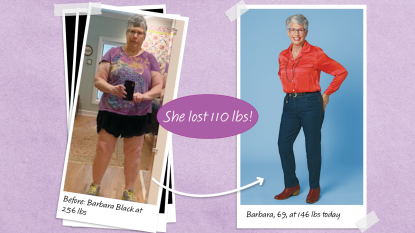One Doctor Used an ‘Elimination Diet’ To Shed Stubborn Pounds and Boost Energy — Here’s How
Eat foods that rev your thyroid to experience slimming results.

Do your best efforts to get healthier usually end with disappointment, low energy and weight gain? You’re not alone, says popular TikTok doctor Emi Hosoda, MD, who once experienced similar results. “I even went on a 1,200-calorie vegan diet and didn’t take off a single pound,” the Seattle-based internist recalls. At first, she blamed stress and aging. Then a colleague made an offhand comment: “You shouldn’t be so overweight. There must be something wrong with your gut.” Intrigued, Dr. Hosoda turned attention to her belly, eventually going back to school to learn more. She discovered that inflammation in the GI tract can cause hidden thyroid issues, and with the right tests, confirmed this was her problem. Fortunately, she notes that simple steps including adopting an elimination diet (cutting out thyroid-slowing foods) “were life-changing” for weight loss and vitality. Now, she’s sharing her tips and insights on the elimination diet along with her recommended meal plan for best results.
The Factors That Cause Thyroid Issues
You might be wondering what your GI tract has to do with your thyroid, a.k.a. the little gland in your neck that controls metabolism. Turns out, a key reason the thyroid slows down is that the body mistakenly attacks it — and Dr. Hosoda explains these autoimmune attacks “are very often triggered in our gut.”
Here’s the main way it happens: Little by little, things like stress hormones, antibiotics, and irritants in food damage the thin gut lining; if it gets bad enough, tiny tears form and microscopic food particles escape. While scientists don’t fully understand why, this can cause the immune system to malfunction and begin targeting healthy cells and tissue as they would a virus or toxin. And since the thyroid is delicate, Dr. Hosoda notes it’s prone to getting roughed up so much that it becomes sluggish and diseased.
So does your thyroid need help? Symptoms like fatigue, stubborn weight gain, brain fog, and frequent GI issues hint that the answer is yes. Be sure to talk to your doctor; you may need prescription meds to protect your well-being. But most experts agree that Dr. Hosoda’s basic style of eating can benefit virtually everyone. In fact, research shows it can help prevent future issues and even offer significant relief to folks already diagnosed with a slow thyroid.
To be fair, Dr. Hosoda says the perfect gut-soothing diet will be a little different for each of us. If you have access to a functional medicine expert, you can get high-tech tests and a personalized list of foods to avoid. Not an option? No problem! Making changes to your diet is a low-tech approach that gets pretty amazing results too.
The Best Eating Habits To Boost Thyroid Function
The gist of an elimination diet, or autoimmune protocol, is to give your body a break from foods that often cause inflammation and thyroid attacks, “like grains, dairy, sugar, artificial colors and flavors, and any highly processed food,” Dr. Hosoda says. At the same time, you’ll aim to get plenty of nutrients proven to help relieve inflammation and repair damage — especially antioxidants from produce (organic if possible, to avoid pesticide residue), amino acids from high-quality protein, and omega-3s from good fat.
As you narrow down what you eat and pay more attention to your body, you may notice a seemingly healthy food causes bloating or tummy trouble. Remove that item from your diet too. After you give your system time to rejuvenate, you can add things back one at a time and reincorporate any that don’t trigger reactions. “I used to have trouble with coconut, but now that my gut has healed, I can handle it again,” Dr. Hosoda shares. “The key is to find things that are damaging for you and replace them with things that are healing.”
Bonus: “As your gut heals, it becomes better able to absorb nutrients essential for making thyroid hormones, like magnesium and selenium,” Dr. Hosoda notes. A healthy gut also absorbs more minerals like chromium that are key to preventing inflammatory blood-sugar spikes.
For Dr. Hosoda, blood tests showed a significant drop in markers of autoimmune attacks. “I felt energized and better right away. And then the weight started coming off pretty quickly, about 2 to 4 pounds every week or so,” she adds. “If you take steps and don’t get better, a hidden infection or other issues can be at play. Don’t struggle alone. Keep looking until you find a doctor who helps you.”
Dr. Hosoda’s Elimination Diet Meal Plan for Thyroid Health
To try Dr. Hosoda’s way of eating, use a free app like MyFitnessPal to keep portions healthy and enjoy lots of nonstarchy veggies, protein, and good fats. Include a little low-sugar fruit and grain-free starch like sweet potato, beans, and quinoa into your daily diet. Choose organic or grass-fed ingredients if possible. Also, avoid sugar, dairy, grains, and processed food. Below, you can find three easy meal ideas if you’re following the elimination diet plan:
- Breakfast: Halve and slightly hollow baked sweet potatoes. Brush with olive oil and then add raw eggs. Bake at 375 degrees Fahrenheit until the eggs reach your preferred level of doneness, 10 to 15 minutes.
- Lunch: Dress up a large bowl of spring greens with grilled chicken, fresh berries, nuts, spring onion, and a drizzle of olive oil vinaigrette.
- Dinner: On a sheet pan, top salmon and veggies with olive oil and seasoning. Bake at 375 degrees Fahrenheit until the fish flakes, 15 to 20 minutes.
For more of Dr. Hosoda’s tips, follow @Doctor.Emi on Instagram and TikTok.
This content is not a substitute for professional medical advice or diagnosis. Always consult your physician before pursuing any treatment plan.
A version of this article originally appeared in our print magazine, Woman’s World.













